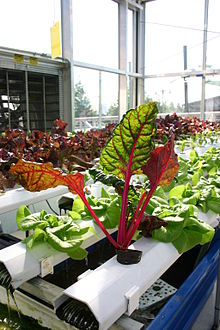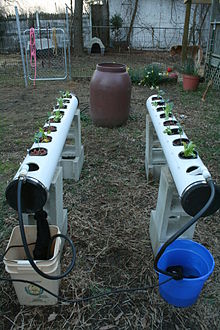Nutrient film technique
This article needs additional citations for verification. (August 2008) |


Nutrient film technique (NFT) is a hydroponic technique where in a very shallow stream of water containing all the dissolved nutrients required for plant growth is re-circulated past the bare roots of plants in a watertight gully, also known as channels.
History[]
NFT was pioneered in 1965 by Allen Cooper at the Glasshouse Crops Research institute in Littlehampton, England.[1] In an ideal system, the depth of the recirculating stream is very shallow, little more than a film of water, hence the name 'nutrient film'. This ensures that the thick which develops in the bottom of the channel receives adequate air exposure.
Description[]
A properly designed NFT system is based on using the right channel slope, the right flow rate, and the right channel length. The plant roots are exposed to adequate supplies of water, oxygen and nutrients. In earlier production systems, there was a conflict between the supply of these requirements, since excessive or deficient amounts of one results in an imbalance of one or both of the others.
NFT, because of its design, provides a system wherein all three requirements for healthy plant growth can be met at the same time, provided that the simple concept of NFT is always remembered and practiced. The result of these advantages is that higher yields of high-quality produce are obtained over an extended period of cropping. A downside of NFT is that it has very little buffering against interruptions in the flow, such as a result of a power outage. But, overall, it is one of the more productive techniques.[citation needed]
The same design characteristics apply to all conventional NFT systems. While slopes along channels of 1:100 have been recommended, in practice it is difficult to build a base for channels that is sufficiently true to enable nutrient films to flow without ponding in locally depressed areas. As a consequence, it is recommended that slopes of 1:30 to 1:40 be used. This allows for minor irregularities in the surface, but, even with these slopes, ponding and waterlogging may occur. The slope may be provided by the floor, or benches or racks may hold the channels and provide the required slope. Both methods are used and depend on local requirements, often determined by the site and crop requirements.
Flow rates[]
As a general guide, flow rates for each gully should be 1 litre per minute. At planting, rates may be half this, and the upper limit of 2L/min appears about the maximum. Flow rates beyond these extremes are often associated with nutritional problems. Depressed growth rates of many crops have been observed when channels exceed 12 metres in length. On rapidly growing crops, tests have indicated that, while oxygen levels remain adequate, nitrogen may be depleted over the length of the gully. As a consequence, channel length should not exceed 10–15 metres. In situations where this is not possible, the reductions in growth can be eliminated by placing another nutrient feed halfway along the gully and reducing flow rates to 1L/min through each outlet.[2] Care needs to be taken to maintain hygienic conditions and to avoid heavy metal contamination of NFT systems by using mainly plastic or stainless steel pumps and components.[3]
Potato minitubers[]
Most potato varieties are maintained in plant tissue culture and micropropagation methods are used to increase the amount of planting material. Since tissue culture plants perform poorly when planted into field soil, they are instead planted into greenhouses or screenhouses to generate tubers, which are referred to as minitubers. In many countries, it is common for NFT or aeroponic systems to be used for production of minitubers from tissue culture plantlets. The minitubers are planted into the field 6 to 14 months after harvest to grow a crop of potatoes. This first crop of field-grown potatoes is typically replanted to generate more potatoes rather than consumed.[4]
Controversy[]
A leading proponent of NFT was Dr. Allen Cooper, a scientist at the Glasshouse Crops Research Station in England who published the book The ABC of NFT.[5] NFT systems were used by a significant proportion of commercial growers in the UK through the 1980-1990 period but were only used for lettuce in Europe. Dutch growers particularly rejected NFT because of the perceived high risk of disease spread by the recirculating solution. NFT ensures that plants have unlimited access to water at all times, but it is now recognized that fruiting crops can benefit from carefully limited water supplies. Leafy crops like lettuce benefit from unlimited water supplies and are still widely grown using NFT, but now most commercial greenhouse crops of tomatoes, capsicums and cucumbers are grown hydroponically using some kind of inert media, with rockwool being the most important medium worldwide. NFT remains a very popular system for home use.[citation needed]
References[]
- ^ Resh, Howard (2004). Hydroponic Food Production. CRC Press. p. 157. ISBN 0-931231-99-X.
- ^ "Archived copy". Archived from the original on 2010-11-30. Retrieved 2010-11-30.CS1 maint: archived copy as title (link), Hydroneeds.com.au
- ^ "Index of /NFT". Archived from the original on 2013-11-03. Retrieved 2013-10-30., GVHI.co.nz
- ^ Frost, Groves, and Charkowski. (2013). "Integrated Control of Potato Pajthogens Through Seed Potato Certification and Provision of Clean Seed Potatoes". Plant Disease. 97. pp. 1268–1280.CS1 maint: multiple names: authors list (link)
- ^ Cooper, Allen (1979). The ABC of NFT. London: Grower Books. ISBN 0958673500.
- Hydroponics
- Agriculture